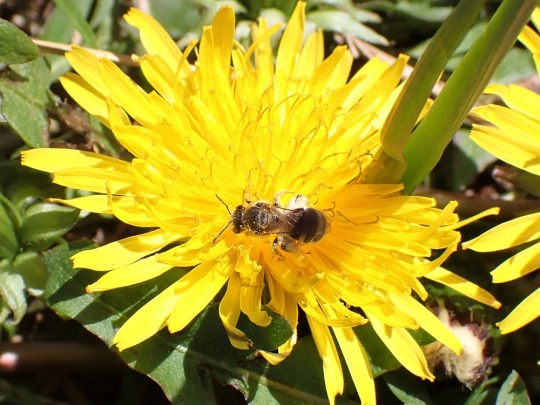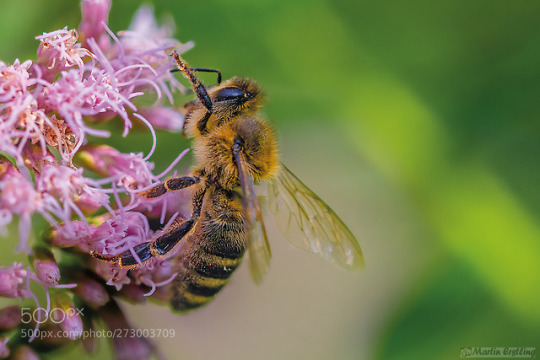#Apiformes
Explore tagged Tumblr posts
Text

Post Captain "They are remarkably adaptable – perhaps the most adaptable of all social insects!"
55 notes
·
View notes
Photo

タンポポに小さいハナバチ。後肢に白い花粉をたくさんつけている(4月10日)
1 note
·
View note
Text
[Étymozoo] Sésie apiforme
See on Scoop.it - EntomoScience

Sésie apiforme - Wikipédia
La Sésie apiforme ou Sésie du peuplier (Sesia apiformis ) est une espèce de lépidoptères (papillons) de la famille des Sesiidae, originaire d' Europe. L' espèce Sesia apiformis a été décrite par le naturaliste suédois Carl Alexander Clerck en 1759, sous le nom initial de Sphinx apiformis.
La Sésie apiforme ou Sésie du peuplier (Sesia apiformis) est une espèce de lépidoptères (papillons) de la famille des Sesiidae, originaire d'Europe.
Wikipédia
version du 10 août 2023 à 12:22
[Image] Sesia apiformis (le mâle est le plus petit)
------
via Taupo sur X, 06.09.2022
"#Etymozoo : Sesia apiformis, du grec sēs (mite) et du latin apis (abeille) et fōrma (forme) : le papillon à l'apparence d'abeille (ou de frelon ici) https://t.co/CZ1roSfv2r"
https://x.com/pierrekerner/status/1567090232515756034
0 notes
Text
VERANO 2023 - ABEJAS
16 de Mayo 2023 - Los martes los vamos a dedicar a DIY o manualidades de animales, hoy empezamos con ideas para hacer ABEJAS...
Como ya os comente ayer, los martes, lo vamos a dedicar a DIY o manualidades de animales propios de esta estación. Las abejas son insectos que pertenecen al orden Hymenoptera, también conocidos como Apiformes o Antofilos (del griego Anthophila, que significa “que ama las flores”). Aproximadamente se conocen 18 000 especies de abejas en todo el mundo y se estima que hay más de 20 000…

View On WordPress
0 notes
Photo

Anflug #hummel, #bumblebee, #hummeln, #apinae, #echtebienen, #apidae, #bienen, #apiformes, #apoidea, #stechimmen, #aculeata, #insekt, #insect, #flug, #fliegen, #flying, #austria, #österreich🇦🇹, #kärnten, #tierphotographie, #insektenFotografie, #matom, #tier, #animal, #wolfsberg (hier: Wolfsberg,K-AT) https://www.instagram.com/p/CcdFs3cqhlP/?igshid=NGJjMDIxMWI=
#hummel#bumblebee#hummeln#apinae#echtebienen#apidae#bienen#apiformes#apoidea#stechimmen#aculeata#insekt#insect#flug#fliegen#flying#austria#österreich🇦🇹#kärnten#tierphotographie#insektenfotografie#matom#tier#animal#wolfsberg
0 notes
Photo

Dancing Bee by martinerstling
#wildlife#Apiformes#Apoidea#Bee#Biene#Bug#Elbe#Foto-Technik#Gliederfüßer#Honigbiene#Insect#Insecta#In
1 note
·
View note
Photo

Hummel “Bombus” Artwork
#original photographers#photographers on tumblr#bombus#insectphotography#artwork#apiformes#apidae#insectart#insectphoto
105 notes
·
View notes
Photo

On the top! by martinerstling http://500px.com/photo/258171063 #macro
#Apiformes#Apoidea#Bee#Biene#Blume#Blumen#Blüte#Blüten#Botanik#Bug#Farben#Fauna#Foto-Technik#Gliederf
1 note
·
View note
Photo

Hylaeus spec., Reseda lutea Gelber Wau, Maskenbienen Notizblog 19: ..., Systematik, Taxonomie, Reseda lutea Rosiden, Eurosiden II, Ordnung: Kreuzblütlerartige (Brassicales),
#Apiformes#Apoidea#Art: Gelber Wau#Überfamilie: Apoidea#Bienen#Brassicales#Colletidae#Eurosiden II#Fabricius 1793#Familie: Colletidae#Familie: Resedagewächse (Resedaceae)#Gattung: Maskenbienen#Gattung: Reseda#Gelber Wau#Hautflügler#Hylaeus#Hymenoptera#Kreuzblütlerartige#L.#Maskenbienen#ohne Rang: Bienen (Apiformes)#Ordnung: Hautflügler (Hymenoptera)#Ordnung: Kreuzblütlerartige (Brassicales)#Reseda#Reseda lutea#Resedaceae#Resedagewächse#Rosiden#Wissenschaftlicher Name: Hylaeus#Wissenschaftlicher Name: Reseda lutea
0 notes
Note
i learned yesterday that the biggest bee (a mason bee, length up to 1.5 inches) builds its home into the active nests of tree dwelling termites and thats hardcore and i am sappy about apiformes
oh yeah I think that's why it took scientists so long to find the dang thing in the first place!
it's Wallace's Giant Bee from Indonesia and it's amazing but no one thought to look for it in freaking termite nests
(except for the people who already lived there, but they don't count I guess. they also gave it a way cooler name, Raja Ofu- King of Bees, but again doesn't count I guess)

411 notes
·
View notes
Text
Fragiles papillons | Illustré
See on Scoop.it - Variétés entomologiques
Aérienne et chatoyante, leur présence enchante la terre. Fascinés, les photographes allemands Heidi et Hans-Jürgen Koch ont exploré la beauté et la diversité des papillons de très, très près.
Par Mireille Monnier publié le 26 janvier 2019 - 14:05, modifié 18 janvier 2021
"... Il y a le plus effrayant, Creatonotos gangis, dont l’apparence d’extraterrestre a récemment fait le buzz sur les réseaux sociaux, le plus puant, Macrocilix Maia, qui dégage des relents de fiente d’oiseau, et le migrateur fou, comme le monarque, qui franchit plus de 4500 kilomètres. Il y a la sésie apiforme qui joue les frelons, le moro-sphinx qui connaît le secret du vol stationnaire, le Bombyx mori qui produit de la soie. Tous ou presque dotés d’une beauté aérienne, mariage de couleur et de lumière, qui fait d’eux les insectes les plus admirés du monde – mais des insectes tout de même, et donc en train de disparaître. Très vite. Leur nombre aurait diminué de 50 à 75% ces vingt-cinq dernières années, selon une étude européenne."
(...)
[Image] La saturnie du chêne du Japon («Antheraea yamamai») fut introduite en France au milieu du XIXe siècle pour remplacer le ver à soie. Les mâles sentent et goûtent avec leurs antennes plumeuses. Heidi & Hans-Jürgen Koch
0 notes
Text

Crocus - iridaceae et apiformes - hymenoptera
8 notes
·
View notes
Video
instagram
#APIFORMES BEE 🐝 @ #hazel #bush #imkerei #imkereibedarf #bienen #biene #honigbiene #urbanbee #beehive #urbanbee #urbanbeekeeping #traditionalbeekeeping #savethebees #naturalbeekeeping #apicultura #apis #bee #apismellifera #honigbiene🐝 A❤️🐝 @apiformes.de #www.apiformes.de
#imkerei#apiformes#imkereibedarf#traditionalbeekeeping#bush#bienen#biene#apis#beehive#naturalbeekeeping#bee#honigbiene#savethebees#apismellifera#urbanbee#urbanbeekeeping#www#hazel#honigbiene🐝#apicultura
0 notes
Photo

Sésie apiforme ou Sésie frelon ou Sésie du peuplier ( Sésia apiformis ) by Le Papa'razzi Un frelon ? Point du tout ! La Sésie apiforme est un PAPILLON ! Mimétique d'Hyménoptères, ce papillon peut induire en erreur . Mais pourquoi ? Chez les insectes, le jaune et le noir sont des couleurs dîtes aposématiques, c'est-à-dire qu'elles indiquent un danger potentiel. Les prédateurs (oiseaux) assimilent ces couleurs à des insectes plus dangereux (ici les frelons) et vont préférer consommer d'autres insectes. En prenant les couleurs d'un insecte venimeux, la sésie apiforme sauve sa peau de ce fait ! Image prise dans un milieu naturel . PS : Un grand merci à toutes celles et ceux qui choisissent de regarder , de commenter et d'aimer mes photos . C'est très apprécié , comme vous l'avez constaté , je ne répond plus directement suite à votre commentaire juste pour dire en fait " merci et bonne journée " , mais en retour je passe laisser une petite trace chez vous sur une ou plusieurs de vos éditions . Merci de votre compréhension *************************************************************** A hornet? Not at all ! The Apiform Borer is a BUTTERFLY! Mimetic of Hymenoptera, this butterfly can be misleading. But why ? In insects, yellow and black are so-called aposematic colors, that is, they indicate a potential danger. Predators (birds) assimilate these colors to more dangerous insects (here hornets) and will prefer to consume other insects. By taking the colors of a poisonous insect, the apiform borer saves its skin as a result! Image taken in a natural environment. PS: Many thanks to everyone who chooses to view, comment and love my photos. It is very appreciated, as you noticed, I do not answer any more directly following your comment just to say in fact "thank you and have a good day", but in return I pass to leave a small mark with you on one or more of your editions. thank you for your understanding https://flic.kr/p/2jqe1qu
0 notes
Photo

Searching for gold by martinerstling http://ift.tt/2DwsKIj #macro
#Apiformes#Apoidea#Bee#Biene#Blume#Blumen#Blüte#Blüten#Botanik#Bug#Farben#Fauna#Foto-Technik#Gelb#Get
1 note
·
View note
Text
Anthidium manicatum, Große Wollbiene, Cirsium oleraceum, Kohl-Kratzdistel


190805, 153700, Große Wollbiene

190805, 154300, Anthidium manicatum, Große Wollbiene, Cirsium oleraceum, Kohl-Kratzdistel
Anthidium manicatum, Große Wollbiene, Cirsium oleraceum, Kohl-Kratzdistel
Notizblog Naturbeobachtungen: https://wp.me/p9TZZ6-nf, …,
Systematik, Große Wollbiene
Ordnung: Hautflügler (Hymenoptera), Überfamilie: Apoidea, Bienen (Apiformes), Familie: Megachilidae, Gattung: Harz-…
View On WordPress
#(L.) Scop.#(Linnaeus 1758)#Anthidium#Anthidium manicatum#Apiformes#Apoidea#Arnó#Arno Beierlein#Arnulf Beierlein#Art: Große Wollbiene#Art: Kohldistel#Asteraceae#Asterales#Asternartige#Überfamilie: Apoidea#Bienen#Bienen (Apiformes)#Bildhauer Beierlein#Carduoideae#Cirsium#Cirsium oleraceum#Cynareae#Familie: Korbblütler (Asteraceae)#Familie: Megachilidae#Foto#Gattung: Harz- und Wollbienen (Anthidium)#Gattung: Kratzdisteln (Cirsium)#Große Wollbiene#Harz- und Wollbienen#Hautflügler
0 notes